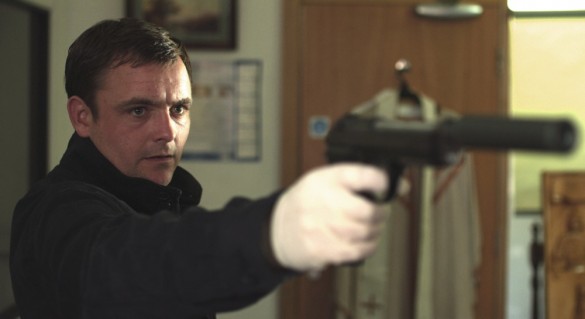Ben Wheatley’s debut Down Terrace, about a Brighton crime family whose bickering resembles Abigail’s Party, then Macbeth, had almost no budget and was literally home-made. Many critics still realised that it was one of the best and most original films of 2010. With its cult success repeated in the US, Wheatley has quickly followed it with the most assured and troubling British horror film in many years. Kill List confirms his promise while pinning you to your seat with scenes of cold nightmare.
We begin in a deceptively similar milieu to Down Terrace, at the suburban home of working-class Jay (Neil Maskell) and wife Shel (MyAnna Buring). When Jay follows a blazing row by telling their adored seven-year-old son a bedtime story about Daddy’s recent time in Iraq we’re assured that, for all his mood swings, he’s a loving family man. The arrival of fellow veteran Gal (Michael Smiley) and apparently dim new girlfriend Fiona (Emma Fryer) for the sort of boozy, chaotic dinner party also familiar from Down Terrace deepens the belief that we’re on familiar ground. When Gal offers Jay the financial lifeline of a spot of freelance assassination, we sit back to enjoy Wheatley (co-writer as well as director) adding cleverly bantering working-class hitmen to his debut’s gangsters.
Both Wheatley’s films are comedy-dramas, in the way that most lives are. Jay’s verbal demolition of a bunch of happy-clappy Christians getting on his nerves during hotel breakfast is especially funny. But no more so than the scene when Gal, told by Jay to wait five minutes before following him into a warehouse, creeps through it to the sound of ominous thuds, and finally stumbles upon his pal drenched in blood, beating his hapless quarry to a pulp. “Was that five minutes?” Jay, lost in his work, enquires.
 We’ve already been through the gruelling scene on which Kill List pivots. Jay (pictured), provoked by laptop footage we never see of screaming people (tortured children?), takes a hammer to the man he blames, who thanks him between screams, till he has no mouth. The camera doesn’t flinch when you hope it will. It’s a sort of sequel to Reservoir Dogs’s infamous ear-slicing (more visceral and far less funny on first viewing than it seems now). The careful opposite of Saw’s torture porn, it resensitises you to violence and agony when you thought you’d seen it all. Martin Pavey’s subliminally sickening sound design adds to the fear of unguessable awfulness, in the second half of the film that now looms.
We’ve already been through the gruelling scene on which Kill List pivots. Jay (pictured), provoked by laptop footage we never see of screaming people (tortured children?), takes a hammer to the man he blames, who thanks him between screams, till he has no mouth. The camera doesn’t flinch when you hope it will. It’s a sort of sequel to Reservoir Dogs’s infamous ear-slicing (more visceral and far less funny on first viewing than it seems now). The careful opposite of Saw’s torture porn, it resensitises you to violence and agony when you thought you’d seen it all. Martin Pavey’s subliminally sickening sound design adds to the fear of unguessable awfulness, in the second half of the film that now looms.
The only clue to what follows rests in the Client (Struan Rodger), a formidably dissolute, almost silent aristocrat, whose mouth hangs open in predatory amusement at the hitmen he’s hired. The wound he carves in Jay’s palm to sign their deal in blood becomes infected, along with Jay’s grip on reality. There’s a touch of Rosemary’s Baby as even the doctor that the self-medicating, frightened and volatile veteran is sent to seems part of a paranoid plot.
Kill List is set partly in the blank motorway hotels that dot modern England (though filmed around Sheffield, it’s this anonymous interzone which gives its sense of place). But by its final reel, older, rustic horrors are intruding. The giddying lurch when this happens teeters on the risible, dispelling the grim urban fear preceding it. It took just minutes for the ferocity of the subsequent nightmare to breathlessly snuff my resistance. Even a final scene which first struck me as disappointingly obvious lodged in my mind later.
Kill List combines smoothly efficient construction worthy of John Carpenter with mystery it refuses to dispel; cool reality with something feverish. It feels like a landmark British film, another step in Wheatley’s resurrecting of moribund genres he approaches with respect, and makes uncomfortably real.














Add comment